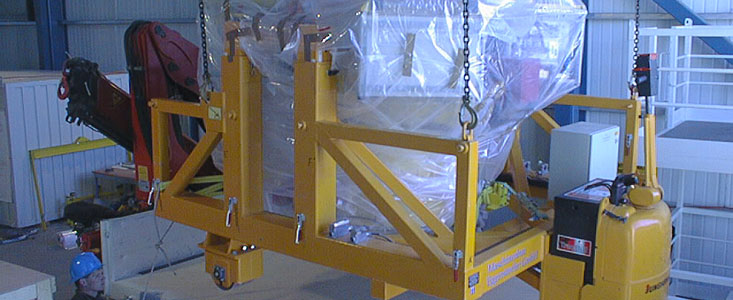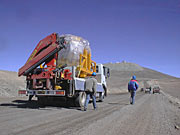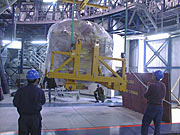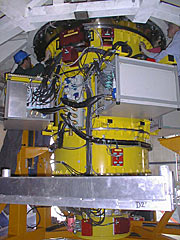Persbericht
First Major Astronomical Instrument Mounted on VLT
First FORS Images Expected Soon
11 september 1998
After seven years of design and construction, and much preparatory work at Paranal, the first scientific instrument of the VLT, FORS1 , was successfully mounted on the Cassegrain focus of the first 8.2-m VLT telescope (UT1) yesterday. FORS1 and its sister instrument, FORS2 (to be mounted at UT2 towards the end of 1999), have been designed to obtain images and spectra in the visual spectral region of the faintest possible objects.
After seven years of design and construction, and much preparatory work at Paranal, the first scientific instrument of the VLT, FORS1, was successfully mounted on the Cassegrain focus of the first 8.2-m VLT telescope (UT1) yesterday. FORS1 and its sister instrument, FORS2 (to be mounted at UT2 towards the end of 1999), have been designed to obtain images and spectra in the visual spectral region of the faintest possible objects.
FORS1 was assembled in the Instrument Area at the Paranal Base Camp and the operation began by the loading of FORS1 onto the Instrument Carriage. It was then hoisted onto the ESO 10-ton truck and slowly transported up the mountain to the UT1 enclosure in the morning of September 10. Here it was carefully lifted from the truck using the big M1 Lift Platform as a crane. It was driven inside the building and hoisted to the Azimuth platform with the enclosure crane.
Late in the afternoon, it was moved under the Cassegrain focus, then lifted and bolted to the flange inside the main mirror cell (M1 cell). The entire operation went very smoothly and this was a great moment for all involved!
There is still much work to be done before FORS1 will become fully operational. The detector must be prepared and installed, connections for power and communications have to be made and the proper functioning of all instrument components on the telescope under software control have to be carefully verified. Only then will FORS1, for the first time, "see" the light from stars and galaxies and begin to explore the universe. If all goes well, FORS1 will produce its first test images within a few days.
FORS1 and FORS2 are built under ESO contract by a Consortium of German institutes, including Landessternwarte Heidelberg, Universitäts-Sternwarte Göttingen and Universitäts-Sternwarte München.
Over dit bericht
| Persberichten nr.: | eso9841 |
| Legacy ID: | Photo 34a-f/98 |
| Naam: | FORS1, Very Large Telescope |
| Type: | Unspecified : Technology : Observatory : Instrument |
| Facility: | Very Large Telescope |
| Instruments: | FORS1, FORS2 |
Our use of Cookies
We use cookies that are essential for accessing our websites and using our services. We also use cookies to analyse, measure and improve our websites’ performance, to enable content sharing via social media and to display media content hosted on third-party platforms.
ESO Cookies Policy
The European Organisation for Astronomical Research in the Southern Hemisphere (ESO) is the pre-eminent intergovernmental science and technology organisation in astronomy. It carries out an ambitious programme focused on the design, construction and operation of powerful ground-based observing facilities for astronomy.
This Cookies Policy is intended to provide clarity by outlining the cookies used on the ESO public websites, their functions, the options you have for controlling them, and the ways you can contact us for additional details.
What are cookies?
Cookies are small pieces of data stored on your device by websites you visit. They serve various purposes, such as remembering login credentials and preferences and enhance your browsing experience.
Categories of cookies we use
Essential cookies (always active): These cookies are strictly necessary for the proper functioning of our website. Without these cookies, the website cannot operate correctly, and certain services, such as logging in or accessing secure areas, may not be available; because they are essential for the website’s operation, they cannot be disabled.
Functional Cookies: These cookies enhance your browsing experience by enabling additional features and personalization, such as remembering your preferences and settings. While not strictly necessary for the website to function, they improve usability and convenience; these cookies are only placed if you provide your consent.
Analytics cookies: These cookies collect information about how visitors interact with our website, such as which pages are visited most often and how users navigate the site. This data helps us improve website performance, optimize content, and enhance the user experience; these cookies are only placed if you provide your consent. We use the following analytics cookies.
Matomo Cookies:
This website uses Matomo (formerly Piwik), an open source software which enables the statistical analysis of website visits. Matomo uses cookies (text files) which are saved on your computer and which allow us to analyze how you use our website. The website user information generated by the cookies will only be saved on the servers of our IT Department. We use this information to analyze www.eso.org visits and to prepare reports on website activities. These data will not be disclosed to third parties.
On behalf of ESO, Matomo will use this information for the purpose of evaluating your use of the website, compiling reports on website activity and providing other services relating to website activity and internet usage.
Matomo cookies settings:
Additional Third-party cookies on ESO websites: some of our pages display content from external providers, e.g. YouTube.
Such third-party services are outside of ESO control and may, at any time, change their terms of service, use of cookies, etc.
YouTube: Some videos on the ESO website are embedded from ESO’s official YouTube channel. We have enabled YouTube’s privacy-enhanced mode, meaning that no cookies are set unless the user actively clicks on the video to play it. Additionally, in this mode, YouTube does not store any personally identifiable cookie data for embedded video playbacks. For more details, please refer to YouTube’s embedding videos information page.
Cookies can also be classified based on the following elements.
Regarding the domain, there are:
- First-party cookies, set by the website you are currently visiting. They are stored by the same domain that you are browsing and are used to enhance your experience on that site;
- Third-party cookies, set by a domain other than the one you are currently visiting.
As for their duration, cookies can be:
- Browser-session cookies, which are deleted when the user closes the browser;
- Stored cookies, which stay on the user's device for a predetermined period of time.
How to manage cookies
Cookie settings: You can modify your cookie choices for the ESO webpages at any time by clicking on the link Cookie settings at the bottom of any page.
In your browser: If you wish to delete cookies or instruct your browser to delete or block cookies by default, please visit the help pages of your browser:
Please be aware that if you delete or decline cookies, certain functionalities of our website may be not be available and your browsing experience may be affected.
You can set most browsers to prevent any cookies being placed on your device, but you may then have to manually adjust some preferences every time you visit a site/page. And some services and functionalities may not work properly at all (e.g. profile logging-in, shop check out).
Updates to the ESO Cookies Policy
The ESO Cookies Policy may be subject to future updates, which will be made available on this page.
Additional information
For any queries related to cookies, please contact: pdprATesoDOTorg.
As ESO public webpages are managed by our Department of Communication, your questions will be dealt with the support of the said Department.






